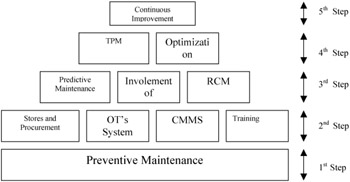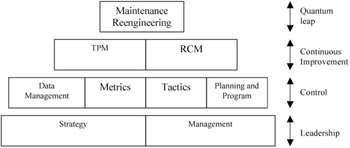Maintenance Management Framework
|
We now turn to the description of a framework defined as the essential supporting structure and the basic system needed to properly manage maintenance in an organization. In doing so, we also discuss the process, the course of action and the series of stages to be followed. First, we present a review of the most interesting contributions found in literature about these issues. Then, we propose our own framework by synthesis of observed ideas and schemes.
Pintelon and Gelders (1992) discuss a maintenance management (MM) framework consisting of the following three building blocks:
-
The first building block is the management system design. Here, MM is placed in a broader business context where marketing, finance and operations interact to avoid each function to pursue its own limited objectives. MM is considered as one of the areas of the operations function.
-
The second building block is maintenance management decision making: planning and control, includes decisions the maintenance manager should make at the three levels of business activity, management of resources and performance reporting. More technical maintenance theories and methods are not included.
-
The last building block is called maintenance management toolkit, consisting of statistics tools to model the occurrence of failures in the system, plus OR/OM techniques, and computer support.
Vanneste and Vassenhove (1995) propose an approach to the maintenance management process consisting of two parts: the effectiveness analysis and the efficiency analysis. The first part has to do with detecting the most important problems and potential solutions. The second part has to do with the identification of the suitable procedures. Their MM approach consists of the following eight phases:
-
Determination of current factory performance
-
Quality and downtime problem analysis
-
Effectiveness analysis of alternative solutions
-
Efficiency analysis of maintenance procedures
-
Plan actions
-
Implementing actions and gather data
-
Monitor actions and process data
-
Adapt plans or information procedures. In case of undesired deviations, go to phase 1.
Wireman (1998) proposes a sequential implementation of steps to ensure that all functions for maintenance management are in place: (1) preventive maintenance, (2) inventory and procurement, (3) work order system, (4) CMMS, (5) technical and interpersonal training, (6) operational involvement, (7) predictive maintenance, (8) RCM, (9) TPM, (10) statistical financial optimization, (11) continuous improvement. The pyramid Figure 1 depicts these initiatives as the building blocks of the maintenance management process. Wireman (1998) thinks that a preventive maintenance program should be in place before we move to the next level, the CMMS implementation, and other maintenance resources management components. Suitable work orders and maintenance resources management actions are required before we consider the implementation of RCM, predictive maintenance programs. In addition, operations management must be aware of the importance of the maintenance function. Operators as well as general employees' involvement will be the next level in the process. TPM programs will help in that purpose. Utilization of optimization techniques completes the necessary maintenance organization's structure for continuous improvement.

Figure 1: Maintenance Management Process Construction (Wireman, 98).
Wireman (1998) also defines a set of indicators divided by groups: (a) corporate, (b) financial, (c) efficiency and effectiveness, (d) tactical and (e) functional performance. The above indicators must be properly connected to corporate indicators. The goal of the performance indicators is to make strategic objectives clear, tie core business processes to the objectives, focus on critical success factors, track performance trends, and identify possible solutions to the problems.
Campbell (1998) established a structure for maintenance management presented in Figure 2. The process of maintenance management starts necessarily by the development of a strategy for each asset that is fully integrated with the business plan. At the same time, aspects related to human resources are required to produce the needed cultural change. The organization should gain control and ensure assets productivity along their life cycle. This can be done through the implementation of such systems as a CMMS and a maintenance measurement system for planning and scheduling the maintenance activities. Among the tactics available to accomplish this, Campbell includes the following:
-
Run to failure
-
Redundancy
-
Scheduled replacement
-
Scheduled overhauls
-
Ad-hoc maintenance
-
Preventive maintenance, age or use based
-
Condition based maintenance
-
Redesign

Figure 2: Stages in the Process of Managing Maintenance (Campbell, 1998).
Finally, Campbell proposes the implementation of two of the most successful methods for the continuous improvement implementation, RCM and TPM. For quantum leap improvements in maintenance, he suggests the use of process reengineering techniques.
Pintelon and Van Vassenhove (1990) present a maintenance management tool to evaluate maintenance performance. They suggest the use of a control board and a set of reports to analyze the following ratios: a ratio report, a follow-up report, and a standard report. This tool is examined in five different domains falling under the control of the maintenance manager: cost/budget, equipment performance, personnel performance, materials management and work order control. For each of these aspects, the control board has a ratio with actual, expected, target, notes and attention data.
A generic framework for integrating the maintenance management is presented by Hassanain et al. (2001) for built-assets. Their framework consists of the following five sequential management processes:
-
Identify asset
-
Identify performance requirements
-
Assess assets current performance
-
Plan maintenance
-
Management of the maintenance operations.
Hassanain et al (2001) use an object model where the objects requirements and relationships for the exchange and sharing of maintenance information between applications are defined. Another interesting and integrative approach is described by Yoshikawa (1995). The idea is to pursue a more holistic approach in order to systemize the maintenance knowledge as a whole, making available the right information at the right place and at the right time in order to meet organizational agility for maintenance purposes (Morel el al., 2001).
In contrast to the existing literature, we think that maintenance management consists of specific maintenance related actions at the three levels of business activity: strategic, tactical, and operational. Actions at the strategic level deal with transforming business priorities into maintenance priorities and designing mid-long term strategies to address current and/or potential gaps in equipment performance. As a result, a generic maintenance plan will be obtained at this level. Actions at the tactical level deal with the correct assignment of maintenance resources to fulfil the maintenance plan. As a result, a detailed program will be obtained with all task and resources assigned. Actions at the operational level ensure that the maintenance tasks are carried out by skilled technicians in the time scheduled, following the correct procedures, and using the proper tools. As a result, work will be done and data will be registered in an information system.
To enable and to ease the maintenance management process in an organization (at the three mentioned levels), we need to build a basic supporting structure. This structure will contain a set of main pillars characterized below:
-
The IT Pillar. We believe that CMMS is fundamental for effective maintenance management. This will allow us to have access to the equipment's data. It will also transform this data into information that will be used to prioritize actions and to make better decisions at the three levels of business structure. The CMMS will allow the proper control of the system and will be more important when the number of items to maintain and the complexity of the plant are higher. CMMS will be a critical tool to the three levels of maintenance activity in the organization. The IT Pillar also includes some monitoring technologies that will improve maintenance management efficiency, focusing continuously on the tactical and operational decisions and actions.
-
The Maintenance Engineering Techniques Pillar. Besides the IT tools, a set of key techniques are another pillar of the maintenance management framework. RCM plays an important role in the strategic and tactical levels, defining maintenance plans to ensure desired equipment reliability. TPM focuses organizational efforts at the operational level to improve overall equipment effectiveness. Stochastic tools can be used to model the failures, allowing further use of quantitative techniques to optimize the maintenance management policies. Other OR/MM techniques focus on optimizing maintenance resources management. Interesting case studies about RCM and TPM can be found in Deshpande and Modak (2002) and Chand and Shirvani (2002), respectively. Further, some real life applications of optimization tools can be found in Crespo Marquez and Sanchez Herguedas (2002). These techniques are relatively more useful at the tactical level.
-
The Organizational Techniques Pillar. This pillar is as important as the previous ones and deals with the three levels of maintenance activity. Here, we include all techniques to foster relationships competency at the three levels of business activity. The purpose of these techniques is to ensure the best interface between different activity levels, different functions within the organization, and inter-organizational relationships. A good foundation for this pillar is a suitable level of motivation and involvement of the staff.
Summarizing the above discussion, our proposed process and framework for maintenance management is depicted in Table 2. The processes in Table 2 are continuous closed loop processes where feedback will be used for permanent improvement.
| Maintenance Management Process | Strategic | From business plan to maintenance plan, definition of maintenance priorities. A closed loop process. |
| Tactic | From the maintenance plan to the resources assignment and task scheduling. A closed loop process. | |
| Operational | Proper task completion and data recording. A closed loop process. | |
| Maintenance Management Framework | IT | CMMS, condition monitoring technologies. |
| Maintenance Engineering Techniques | RCM, TPM, reliability data analysis, maintenance policy optimization models, OR/MM models. | |
| Organizational Techniques | Relationships management techniques, motivation, operators involvement, etc. |
|
EAN: 2147483647
Pages: 195